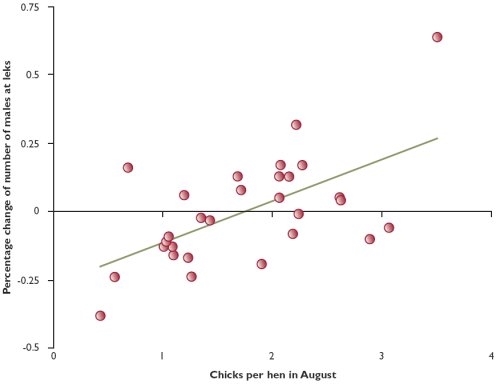Key findings
- Black grouse breeding success was lower in northern England than in either the Scottish Highlands or North Wales.
- Conversely, both juvenile and adult survival tended to be lower in Wales than in either northern England or the Scottish Highlands.
- Predation was the main cause of death in full-grown birds in all regions, with foxes and raptors most important in Wales and the Scottish Highlands and stoats in northern England.
During the last century black grouse declined in numbers and range throughout virtually all Western and Central Europe following habitat loss, degradation and fragmentation as a result of agricultural intensification and changes in forest management. In the UK, the decline started over 100 years ago, but has accelerated more recently, with a range contraction of 28% between 1972 and 1991. In 1995/96 there were estimated to be 6,500 males but, by 2005, this had dropped to 5,100 males.
Declines over the last 20 years have been greatest in Central and Southern Scotland and parts of Wales, which contrasts with relative stability in northern England. We compared black grouse breeding success and survival in North Wales, the North Pennines (northern England) and Strathspey and Deeside (Scottish Highlands). The habitats occupied by black grouse differ markedly between the three regions. In the Scottish Highlands, our study birds were associated with edges of old scots pine forest, which contrasted with virtually treeless marginal farmland used in northern England. Welsh birds lived on the edges of heather moorland and younger stands of commercial spruce forests.
We gathered data on black grouse breeding success between 1997 and 2002 from North Wales, six of which hosted more than 80% of the Welsh black grouse population. Breeding success varied significantly among the three regions, being lowest in northern England with 1.26 (+ 0.22se) chicks per female and highest in the Scottish Highlands (1.65 + 0.25se) and North Wales (1.73 + 0.25se). A longer time series of counts from 1989 onwards showed that patterns of annual breeding success were correlated between England and Scotland (see Figure 1) suggesting that annual weather patterns common across regions may determine breeding success. These data also showed that the number of males attending leks increased following years of high breeding success (see Figure 2).
Figure 1: Breeding success of black grouse in England and Scotland showing a positive correlation, 1989-2004

We monitored 101 breeding attempts by radio-tagged females in northern England and we were able to break down breeding success into clutch and brood survival. The percentage of hens that successfully reared a brood varied annually from 6% to 42% in response to yearly variations in brood survival ranging from 10% to 73% (see Table 1). Neither clutch size (mean 8.2 eggs) nor clutch survival (the percentage of clutches from which one or more eggs hatched, mean 63%) differed among years. Of the clutches that failed to hatch, 88% were predated; 75% by mammalian predators, with stoats taking 57%. We did not gather information on the causes of chick losses.
Figure 2: Number of males at leks compared with breeding success the previous year

We estimated survival rates of radio-tagged juveniles and adults from 147 individuals at 15 sites in northern England between 1998 and 2004, from 28 birds at four sites in the Scottish Highlands between 2002 and 2004, and from 39 birds at one site in North Wales between 1999 and 2003. In Wales, the data were collected by Gordon Bowker, funded by Severn Trent Water. We found a non-significant trend for lower survival rates of juveniles in North Wales, with a survival probability of only 0.18 per six months, compared with 0.56 in the Scottish Highlands and 0.65 in northern England. Similarly, annual adult survival was lower in North Wales (0.44) than in either northern England (0.70) or the Scottish Highlands (0.66). Cause of death differed among regions, with poor survival at the Welsh site being associated with 61% of birds being killed by raptors and 33% by foxes. This was similar to the Scottish Highlands where 48% of birds were killed by foxes and 40% by raptors. In northern England, 41% of birds were killed by stoats, but only 30% by raptors and 11% by foxes.
There is now a series of black grouse recovery projects in the UK, so an understanding of the life stages that limit population size in each project area is critical.
Table 1: Clutch survival (the proportion of clutches that hatched one or more eggs), brood survival (the proportion of broods that fledged one or more chicks) and overall breeding success (the proportion of clutches from which at least one chick fledged) from radio-tagged female black grouse in northern England 1999 and 2004
| Year |
Clutch survival |
|
Brood survival |
|
Breeding success |
|
| |
n |
Hatch |
n |
Survive |
n |
Fledge |
| 1999 |
8 |
0.50 |
4 |
0.25 |
8 |
0.13 |
| 2000 |
15 |
0.80 |
9 |
0.22 |
12 |
0.17 |
| 2001* |
|
|
|
|
|
|
| 2002 |
17 |
0.59 |
10 |
0.10 |
17 |
0.06 |
| 2003 |
31 |
0.65 |
15 |
0.73 |
26 |
0.42 |
| 2004 |
30 |
0.60 |
18 |
0.56 |
30 |
0.33 |
* Foot and mouth disease prevented data collection
Further reading
Baines, D., Warren, P. & Richardson, M. (2007). Variations in the vital rates of black grouse Tetrao tetrix in the United Kingdom. Wildlife Biology, 13 Supplement 1: 109-116. Abstract